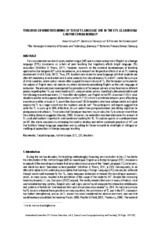Towards an understanding of target language use in the EFL classroom: a report from Norway
Autor
Krulatz, Anna
Neokleous, Georgios
Vik Henningsen, Frøydis
Editor
Universidad de Córdoba, UCOPressFecha
2016Materia
Target languageMother tongue
EFL
EFL teachers
METS:
Mostrar el registro METSPREMIS:
Mostrar el registro PREMISMetadatos
Mostrar el registro completo del ítemResumen
For a considerable number of years, mother tongue (MT) use has been ostracized in English as a foreign
language (EFL) classrooms as a form of poor teaching that negatively affects target language (TL)
acquisition (McMillan & Rivers, 2011). However, research on the potential disadvantages of teaching
approaches that integrate MT use is inconclusive, as is research on the positive effects of an all-TL learning
environment (Hall & Cook, 2012). Thus, EFL teachers who share the same language with their students are
often left wondering to what extent and in what contexts they should employ TL and MT. Unlike the curricula
of other countries, where policy makers often suggest the maximal use of TL, the Norwegian curriculum for
the subject of English does not contain any direct statements prescribing English as the sole language of
instruction. The present study investigated the perceptions of Norwegian primary school teachers in different
grades regarding their TL use when teaching EFL using an online survey. Specifically, the project addressed
the following research questions: (1) How often do teachers use English in the EFL classroom? (2) In what
situations and for what purposes do teachers use the TL? (3) Is there a correlation between years of teaching
experience and the amount of TL use in the classroom? (4) Do teachers who have college credits in English
employ the TL to a larger extent than the teachers who do not? The participants’ self-reports suggest that
while the TL is used up to 50% of the time, its use varied from giving instructions and stating objectives to
giving praise and criticism. This implies that Norwegian teachers may employ the TL to a lesser extent than
the existing literature suggests (Macaro, 2005). However, no correlation was found between the amount of
TL used and teachers’ expertise in and experience teaching the TL. To caution against an overdependence
on MT, the article concludes by reiterating the need to develop and define systematic practices of MT use
that facilitate foreign language acquisition and by calling for future research to shed light on bilingual or
multilingual approaches in foreign language teaching.

